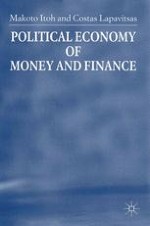
1999 | OriginalPaper | Buchkapitel
Classical Political Economy of Money and Credit
verfasst von : Makoto Itoh, Costas Lapavitsas
Erschienen in: Political Economy of Money and Finance
Verlag: Palgrave Macmillan UK
Enthalten in: Professional Book Archive
Aktivieren Sie unsere intelligente Suche, um passende Fachinhalte oder Patente zu finden.
Wählen Sie Textabschnitte aus um mit Künstlicher Intelligenz passenden Patente zu finden. powered by
Markieren Sie Textabschnitte, um KI-gestützt weitere passende Inhalte zu finden. powered by
The classical theory of money and credit is characterised by the underlying assumption that natural harmony prevails in the operations of the market economy, a harmony that extends to the realm of money and credit. Two distinct traditions can be discerned within classical theory in this respect. On the one hand the quantity theory of money (or the currency school) emphasises the harmonious equilibration of the total quantity of commodity output and the total quantity of commodity money, provided no state or other interference has taken place with the domestic and international operations of the capitalist markets. In this view money is a secondary aspect of capitalist exchange, a Veil’ on real economic activities. Credit money created by banks could upset the presumed harmony, resulting in commodity price disturbances. Thus this tradition supported the introduction of the English Bank Act of 1844 in the hope that the tight quantitative regulation of credit money created by the Bank of England would eradicate capitalist market disturbances.